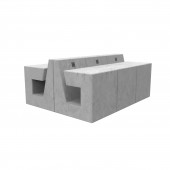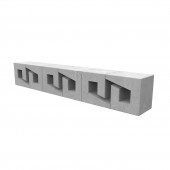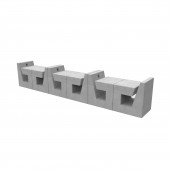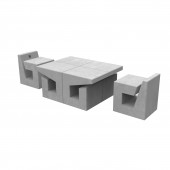
| THE AWARD |
| CATEGORIES |
| REGISTRATION |
| SUBMIT YOUR WORK |
| ENTRY INSTRUCTIONS |
| TERMS & CONDITIONS |
| PUBLICATIONS |
| DATES & FEES |
| METHODOLOGY |
| CONTACT |
| WINNERS |
| PRESS ROOM |
| GET INVOLVED |
| DESIGN PRIZE |
| DESIGN STORE |
| THE AWARD | JURY | CATEGORIES | REGISTRATION | PRESS | WINNERS | PUBLICATIONS | ENTRY INSTRUCTIONS |
B-Shape Concrete Public Seating by Qiu Liwei |
Home > Winners > Design #43211 >Interview |
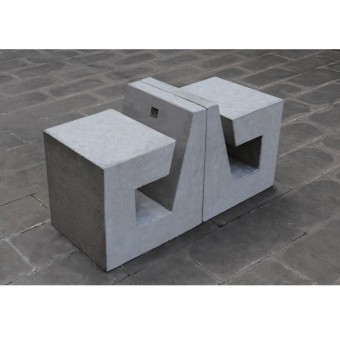 |
|
FS: What is the main principle, idea and inspiration behind your design?
QL: Recovery of architectural waste is the big problem of environment protection. Waste architectural waste generally adopts the handling method of burying and piling, especially in developing countries. Designing and manufacturing public facilities whose materials are regenerative concrete can not only save the transportation expense of aggregate, but also save the land expenses occupied by architectural waste.
FS: What has been your main focus in designing this work? Especially what did you want to achieve?
QL: This works takes the concrete waste as the aggregate of precast concrete to make concrete outdoor facilities, which enables new urban furniture to have ecological features. It adopts modular elements in model to provide the possibility of multiple display. It can be regarded as both a seat and a table. The installation of QR code enables the seat to have the function of location and multi-information service, which is characteristic of information society.
FS: What are your future plans for this award winning design?
QL: Promote this works and play its design value—solve the recycling and reuse of urban construction waste.
FS: How long did it take you to design this particular concept?
QL: 3 months
FS: Why did you design this particular concept? Was this design commissioned or did you decide to pursuit an inspiration?
QL: decide to pursuit an inspiration
FS: Is your design being produced or used by another company, or do you plan to sell or lease the production rights or do you intent to produce your work yourself?
QL: All possible
FS: What made you design this particular type of work?
QL: In daily life, I found that large amount of urban construction waste is difficult to be recycled and reused and I wish to solve this problem effectively by designing a method.
FS: Where there any other designs and/or designers that helped the influence the design of your work?
QL: My instructor offered me a lot of guidance and help, where I learned a lot of knowledge.
FS: Who is the target customer for his design?
QL: Real estate agent, urban planning and designing institution, government
FS: What sets this design apart from other similar or resembling concepts?
QL: When making use of recycled concrete, this design also integrates 2D code technology and 2D code can be installed, which increases positioning and various kinds of information service function.
FS: How did you come up with the name for this design? What does it mean?
QL: Name based on design style of product.
FS: Which design tools did you use when you were working on this project?
QL: Pro/E, cutting tools, measuring tools and concrete mixing tools
FS: What is the most unique aspect of your design?
QL: 2D code can be installed to increase positioning and various kinds of information service function.
FS: Who did you collaborate with for this design? Did you work with people with technical / specialized skills?
QL: My classmates and I participated in this design; meanwhile, we also discussed and worked with people with rich experience and technology.
FS: What is the role of technology in this particular design?
QL: Integrates all ideas and inspiration and finally accomplish design.
FS: Is your design influenced by data or analytical research in any way? What kind of research did you conduct for making this design?
QL: Yes, influenced, make research on the influence of using construction waste as filling material of concrete on its strength.
FS: What are some of the challenges you faced during the design/realization of your concept?
QL: The point lie in both the composition proportion of regenerative concrete. We have attempted many types and failed for many times. Finally we found appropriate proportion and mastered matching techniques.
FS: How did you decide to submit your design to an international design competition?
QL: I hope to share and communicate this design works and inspiration with more friends.
FS: What did you learn or how did you improve yourself during the designing of this work?
QL: I learned continuously discover problems and solve problems, when we solved enough problems, we are successful.
FS: Any other things you would like to cover that have not been covered in these questions?
QL: no
FS: Thank you for providing us with this opportunity to interview you.
A' Design Award and Competitions grants rights to press members and bloggers to use parts of this interview. This interview is provided as it is; DesignPRWire and A' Design Award and Competitions cannot be held responsible for the answers given by participating designers.
| SOCIAL |
| + Add to Likes / Favorites | Send to My Email | Comment | View Press-Release |

